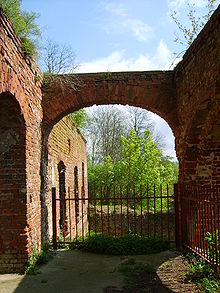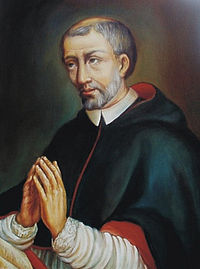- Augustinians
-
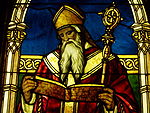
Part of a series on St. Augustine
of HippoMain topics Original sin · Divine grace
Invisible church · Time
Predestination · Infant baptism
Incurvatus in se
Allegorical interpretation
Amillennialism
Augustinian hypothesis
Just WarWorks The City of God
Confessions
On Christian Doctrine
Soliloquies
EnchiridionInfluences and followers Plotinus · St. Monica
Ambrose · Possidius
Hugh of Saint Victor · Thomas Aquinas
Bonaventure · Luther
Calvin · JansenRelated topics Neoplatonism · Pelagianism
Augustinians · Scholasticism
Jansenism
Order of St. AugustineThe term Augustinians, named after Saint Augustine of Hippo (354–430), applies to two separate and unrelated types of Catholic religious orders:
1) several mendicant Orders of friars, who lived a mixed religious life of contemplation and apostolic ministry and follow the Rule of St. Augustine, a brief document providing guidelines for living in a religious community. The largest and most familiar, originally known as the Hermits of Saint Augustine (O.E.S.A. - Ordo Eremitarum sancti Augustini), is now simply referred to as the Order of Saint Augustine (O.S.A.). Two other Orders, the Augustinian Recollects and the Discalced Augustinians, were once part of the Augustinian Order under a single Prior General. The Recollect friars, founded in 1588 as a reform movement of the Augustinian friars in Spain, became autonomous in 1612 with their first Prior General, Enrique de la Sagrada. The Discalced friars became an independent religious congregation with their own Prior General in 1592, and were raised to the status of a separate mendicant Order in 1610.[1]
2) various congregations of clerics, known as canons regular, who also follow the Rule of St. Augustine, and embrace the evangelical counsels and lead a semi-monastic life, while remaining committed to pastoral care, appropriate to their primary vocation as priests. They generally form one large community, which might serve parishes in the vicinity, and are organized into autonomous religious congregations, which normally are distinct by region.
Contents
The Augustinian Friars
Main article: Order of St. AugustineFrom the 2008 Constitutions of the Order of Saint Augustine, we read:-
The Order of Saint Augustine is composed of the following:
- a) friars, whether professed or novices, who are members of the various Circumscriptions of the Order (meaning a Province, Vicariate, or Delegation).
- b) the contemplative nuns belonging to the monasteries of the Order.
- c) the members of the Augustinian Secular Fraternities, legitimately established by the Prior General.
In addition to these three branches, the Augustinian family also includes other groups: a) Religious institutes, both male and female, formally aggregated to the Order by a decree of the Prior General (this would include the Augustinians of the Assumption, the Sisters of St Rita, etc.) b) Other groups of lay Augustinians c) Lay faithful affiliated to the Order[2]
The Augustinian, or Austin, friars (O.S.A.), are a mendicant order. As consecrated religious, they pray the Liturgy of the Hours throughout the day. This Latin Rite Order, while a contemplative Order, differs from traditional monastic Orders in three ways: 1) They do not take vows of stability, meaning that they can live in one house (called a friary or sometimes a monastery) typically for several years before being moved into a different community of the Order. 2) They are engaged in apostolic activity, such as mission work, education, prison ministries, etc. The Order is under the supervision of a Prior General in Rome, and as an international Order they are divided into various Provinces throughout the world, with each Province being led by a Prior Provincial; (3) As an Order, they have a special commitment to corporate poverty as opposed to simply the poverty professed by the individual friar. While this is not currently legislated as it was in the origins of the Order, this is to be a distinguishing mark of their lives as a community.
Like all Catholic religious orders, the Augustinians wear a religious habit, consisting of three pieces: a tunic, a cincture, and a shoulder cape with hood. The tunic and shoulder cape may be black or white (white typically being reserved among the professed friars for tropical locations, and where Dominican friars are not present, so as to avoid confusion), and a black cincture. Novices of the Order wear a white tunic and hooded cape with a black cincture. When white is used by professed friars, however, a scapular is added to the habit, which is the same as the Dominican habit, thus the possible confusion. This is due to St. Dominic's origins as a canon regular.
As consecrated religious, Augustinians profess the evangelical counsels of chastity, poverty, and obedience. They follow the Rule of St. Augustine, written sometime between 397-403, for a monastic community Augustine founded in Hippo (modern day Algeria), and which takes as its inspiration the early Christian community described in the Acts of the Apostles, particularly Acts 4:32: "Now the company of those who believed were of one heart and soul, and no one said that any of the things which he possessed was his own, but they had everything in common" (RSV).
By decree of the Holy See, the Augustinian Order is granted exempt status, which places it under the direct dependence of the Pope, meaning that bishops have no jurisdiction with regards to the internal affairs of the Order.[3]
History of the Friars
The Augustinian friars came into being as part of the mendicant movement of the 13th century, a new form of religious life which sought to bring the religious ideals of the monastic life into an urban setting which allowed the religious to serve the needs of the People of God in an apostolic capacity. At this time there were a number of eremitical groups living in such diverse places as Tuscany, Latium, Umbria, Liguria, England, Switzerland, Germany, and perhaps France. In 1243 the Tuscan hermits petitioned Pope Innocent IV to unite them all as one group. Innocent IV issued the Bull Incumbit Nobis on 16 December 1243, an essentially pastoral letter which, despite its brevity, basically served as the magna carta initiating the foundation of the Order as it is known today. This papal bull exhorted these hermits to adopt "the Rule and way of life of the Blessed Augustine," to profess this Augustinian manner of life in a way that they themselves would decide with regards to specific charism and apostolate, and to elect a Prior General. The bull also appointed Cardinal Riccardo Annibaldi as their supervisor and legal guide. The importance of this man in the foundation of the Order cannot be overstated.[4]
These Tuscan hermits came together for a general chapter in March of 1244, as decreed by the Bull Praesentium Vobis, a chapter presided over by Cardinal Annibaldi. At this chapter the Order formally adopted the Rule of St. Augustine, to follow the Roman office with the Cistercian psalter, and to hold triennial elections of the Prior General. The first Prior General was Friar Matthew, followed by Adjutus and Philip. In the Papal Bull Pia desideria, issued 31 March 1244, Pope Innocent IV formally approved the foundation of the Order.
In 1256 Innocent's successor, Pope Alexander IV, called together various other hermit groups from around the world and ultimately joined them to this existing Augustinian Order. From June to July of 1255 he issued 22 bulls of instruction, encouragement, and protection of the young Order. His bull Cum Quaedam Salubria summoned all the hermits of St. Augustine and St. William to send two representatives to Rome for a General Chapter, again to be held under the supervision of the kindly Cardinal Annibaldi, and during this Chapter the following groups of hermits, inter alia, were amalgamated to the Order, which up to then had only consisted of the groups of the Tuscan hermits: the two Orders of St. William the Hermit (the Malevale and MonteFavale communities), the Brittin, and the Bonites (named after St. John the Good). This historical union has subsequently been referred to as the Grand Union of 1256. At this Chapter Lanfranc Settala, the leader of the Bonites, was elected Prior General. This 12-year-old religious Order of friars now consisted of 100 or more houses.
On 22 August 1256 the Italian Williamites, unhappy with the arrangement of the Grand Union, left the Order and adopted the Rule of St. Benedict.
This early time in the Order's history was characterized by a great devotion to learning, to study, to prayer, to service of the poor, and to defense of the Pope and the Church - a particular charism of the Order rooted in the fact that it is the only Order in the history of the Church to be founded directly by the Pope. The great 14th-century Augustinian historian, friar Jordan of Saxony, O.S.A., in his work The Life of the Brothers, writes:[5]
It is certain that in its modern state the Order is principally founded on spiritual works, those that pertain to the contemplative life. These are as follows:
- the singing of the divine office; the service of the altar; prayer; psalm singing; devotion to reading or study of sacred scripture; teaching and preaching the word of God; hearing confessions of the faithful; bringing about the salvation of souls by word and example.
Organization of the Order
The Augustinian Hermits, while following the rule known as that of St. Augustine, are also subject to the Constitutions, first drawn up by Augustinus Novellus (d. 1309), Prior General of the Order from 1298 to 1300, and by Clement of Osimo. The Rule and Constitutions were approved at the General Chapter held at Florence in 1287 and at Ratisbon in 1290. A revision was made at Rome in 1895. The Constitutions have frequently been printed: at Rome, in 1581, and, with the commentary of Girolamo Seripando, at Venice, in 1549, and at Rome, in 1553. The Constitutions were revised again and published at Rome in 1895, with additions in 1901 and 1907. Today, the Order follows the Constitutions approved in the Ordinary General Chapter of 2007.
The government of the order is as follows: At the head is the Prior General, elected every six years by the General Chapter. The Prior General is aided by six assistants and a secretary, also elected by the General Chapter. These form the Curia Generalitia. Each province is governed by a Prior Provincial, each commissariat by a Commissary General, each of the two congregations by a Vicar General, and every monastery by a Prior (only the Czech monastery of Alt-Brunn in Moravia is under an abbot) and every college by a Rector. The members of the Order number both priests and lay brothers. The Augustinians, like most religious orders, have a Cardinal Protector. The choir and outdoor dress of the friars is a tunic of black woolen material, with long, wide sleeves, a black leather girdle and a large shoulder cape to which is attached a long, pointed hood reaching to the girdle . The indoor dress consists of a black tunic and scapular, over which the shoulder cape is worn. In many monasteries. white was formerly the color worn in areas where there were no Dominicans.
Discalced and Recollect friars
The Discalced Augustinians were formed in 1588 in Italy as a reform movement of the Order, and have their own constitutions, differing from those of the other Augustinians. Their fasts are more rigid, and their other ascetic exercises stricter. They wear sandals, not shoes, a practice which accounts for their name (scalzo or "barefoot"). In an effort to preserve their roots in the hermit life, the Discalced Augustinians practice strict silence and have in every province a house dedicated to recollection situated in some retired place, to which friars striving after greater perfection can retire in order to practice severe penance, living only on water, bread, fruits, olive oil and wine. The Augustinian Recollects developed in Spain in 1592 with the same goal. Currently, though, they are primarily found serving in pastoral care. They were a major force in the evangelization of the Philippines.
The Augustinians in North America
The North American foundation of the Order took place in 1796, when Irish friars arrived in Philadelphia. Michael Hurley was the first American to join the Order the following year. The friars established schools throughout the Americas, including the two Augustinian institutions of higher learning in the United States: Villanova University in Pennsylvania and Merrimack College in Massachusetts.
The following high schools were also established: Malvern Preparatory School in Pennsylvania (1842); St. Rita of Cascia High School in Chicago (1909); St. Augustine High School in San Diego, California (1922); Villanova Preparatory School in Ojai, California (1925); Cascia Hall Preparatory School in Tulsa, Oklahoma (1926); Monsignor Bonner High School in Drexel Hill, Pennsylvania (1953); St. Augustine College Preparatory School in South Jersey (1959); Austin Preparatory School in Reading, Massachusetts (1961) and in 1962, Providence Catholic High School, which serves the Diocese of Joliet in Illinois. The educational and spiritual traditions of the Order enrich each of these academic communities.
Aggregated communities
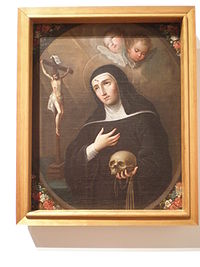 St. Rita of Cascia, O.S.A. (1381-1457).
St. Rita of Cascia, O.S.A. (1381-1457).
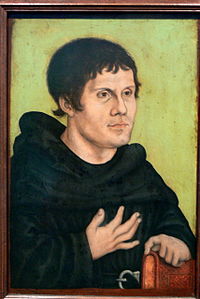 Martin Luther (1483-1546), in the habit of the Augustinian Order. Luther was an Augustinian from 1505 until his excommunication in 1520. Luther would later renounce his monastic vows and marry Katharina von Bora in 1525.
Martin Luther (1483-1546), in the habit of the Augustinian Order. Luther was an Augustinian from 1505 until his excommunication in 1520. Luther would later renounce his monastic vows and marry Katharina von Bora in 1525.

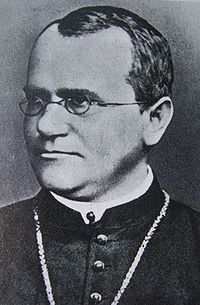 Abbot Gregor Mendel, O.S.A. (1822-1884).
Abbot Gregor Mendel, O.S.A. (1822-1884).
Other orders and groups belong within the Augustinian family either because they follow the Rule of Augustine or have been formally aggregated through their constitutions into the worldwide Augustinian Order. These are not counted comprehensively in this article only because the Catholic Church's system of governance and accounting makes only the numbers of ordained clerics relatively accessible and verifiable. Some of these include:
- The Hieronymites, the Sisters of St Rita, the Ursulines, the Canonesses of St. Augustine of the Mercy of Jesus, the Augustinians of the Assumption (which includes a Byzantine Rite province, the Alexian Brothers (located in the USA, Europe, England, Ireland the Philippines and India), the Brothers of the Assumption (in the Congo), the Sisters of Our Lady of Consolation (Philippines), the Congregation of Our Lady of the Missions, the Sisters of Charity of the Incarnate Word[6] (who established the University of the Incarnate Word in Texas), and the Sisters of St. Joan of Arc (in Quebec, United States, and Rome) are just some of the Augustinian family of orders.
Canons Regular
Main article: Canons RegularThe canons regular follow the more ancient form of Augustinian religious life, which developed toward the end of the first millenium, and thus predates the founding of the friars. They represent a clerical adaptation of monastic life, as it grew out of an attempt to organize communities of clerics to a more dedicated way of life, as St. Augustine himself had done. Historically it paralled the lay movement of monasticism or the eremetical life from which the friars were later to develop. In their tradition, the canons added the commitment of religious vows to their primary vocation of pastoral care. As the canons became independent of the diocesan structures, they came to form their own monastic communities. The official name of the Order is the Canons Regular of St. Augustine (C.R.S.A.).
Like the Benedictines, they do not form one legal body, but are a union of various independent religious congregations. Though they also follow the Rule of St. Augustine, they differ from the friars in not commiting themselves to corporate poverty, which is a defining element of the mendicant orders. Unlike the friars and like monks, the canon are generally organized as one large community to which they are attached for life with a vow of stability. Their houses are given the title of an abbey, from which the canons then serve various surrounding towns and villages for spiritual services. The religious superior of their major houses is titled an abbot. Smaller communities are headed by a prior or provost.
The distinctive habit of the canon regular is the rochet, worn over a cassock or tunic, which is indicative of their clerical origins. This has evolved in various way among different congregations, from wearing the full rochet to the wearing of a white tunic and scapular. The Austrian congregation, as an example, wears a narrow band of white cloth--a vestige of the scapular--which hangs down both front and back over a cassock for their weekday wear. For more solemn occasions, they wear the rochet under a purple mozzetta.
Communities of canons served the poor and the sick throughout Europe, through both nursing and education. They include the canons of the Hospice at the Great St. Bernard Pass in the Alps on the border of Switzerland, where they have served travelers since the mid-11th century. This community is the one which developed the familar canine breed of St. Bernard to assist the canons in their ability to find travelers buried by avalanches.[7]
The Canons Regular of the New Jerusalem are a newly founded Tridentine rite congregation.
Charism
The teaching and writing of Augustine, the Augustinian Rule, and the lives and experiences of Augustinians over sixteen centuries help define the ethos of the order, sometimes "honoured in the breach".
As well as telling his disciples to be "of one mind and heart on the way towards God"[8] Augustine of Hippo taught that "Nothing conquers except truth and the victory of truth is love" (Victoria veritatis est caritas),[9] and the pursuit of truth through learning is key to the Augustinian ethos, balanced by the injunction to behave with love towards one another. It does not unduly single out the exceptional, especially favour the gifted, nor exclude the poor or marginalised. Love is not earned through human merit, but received and given freely by God's free gift of grace, totally undeserved yet generously given. These same imperatives of affection and fairness have driven the order in its international missionary outreach. This balanced pursuit of love and learning has energised the various branches of the order into building communities founded on mutual affection and intellectual advancement. The Augustinian ideal is inclusive.
Augustine spoke passionately of God's "beauty so ancient and so new",[10] and his fascination with beauty extended to music. He taught that "to sing once is to pray twice" (Qui cantat, bis orat) [11] and music is also a key part of the Augustinian ethos. Contemporary Augustinian musical foundations include the famous Augustinerkirche in Vienna where Orchestral Masses by Mozart and Schubert are performed every week, as well as the boys' choir at Sankt Florian in Austria, a school conducted by Augustinian canons, a choir now over 1,000 years old.
Augustinian lay societies
The lay societies are voluntary groups, generally made up of people who are either married or single and have sympathy with, and interest in, the Augustinian approach to life. These lay people do not take monastic vows, but offer support to the work of the Augustinian Order through voluntary work, gifts of money and goods, and of study and promotion of St. Augustine and Augustinian teaching.
The primary among these are the Third Orders associated with the various branches of the mendicant Orders. These are the Augustinian Lay Community [1] and the Secular Augustinian Recollects. They make a formal and public commitment as laity to follow as best as possible the life and charism of the Order.
Other associations which support the spirit and work of the friars and Sisters include: Brotherhood of the Virgin Mary of the Belt in Italy, the Friends of Augustine in the Philippines, the Augustinian Friends in Australia are some examples of Augustinian lay societies.
See also
- Austin Friars St Monica's School
- Augustinian nuns
- Bridgittines
- Canons Regular
- Canons Regular of Saint John Cantius
- Canons Regular of the Immaculate Conception
- Canons Regular of the Lateran
- Dominican Order
- Holy Jesus Hospital
- Independent Augustinian Communities
- Liturgy of the Hours
- Norbertines
- Order of Aubrac
- Order of Augustinian Recollects
- Order of the Canons Regular of Premontre
- Our Lady of Good Counsel
- Society of Saint Augustine
References
- ^ http://oadnet.webs.com/storia.htm
- ^ Rule and Constitutions, Order of St. Augustine, Rome, Augustinian General Curia, 2008
- ^ See BONIFATIUS PP. VIII, Sacer Ordo vester, 21.I.1298; Inter sollicitudines nostras, 16.I.1302, en Bullarium, 44-45. 50-52. CLEMENS PP. VI, Ad fructus uberes, 19.VIII.1347, Ibid., 64-65. Lumen Gentium 45.
- ^ See Rano, Balbino, O.S.A., Augustinian Origins, Charism, and Spirituality, Villanova, Augustinian Press, 1994, 29
- ^ http://augnet.org/default.asp?ipageid=758&iparentid=757
- ^ c.f. The Rule of Saint Augustine and the Constitutions of the Order of the Incarnate Word and Blessed Sacrament New York: Schwartz, Kirwin, and Fauss, 1893, pp. 33–35.
- ^ http://www.gsbernard.ch/
- ^ Augustine of Hippo The Rule of St Augustine Constitutiones Ordinis Fratrum S. Augustini (Rome 1968) Chapter I
- ^ Augustine of Hippo Sermons 358,1 "Victoria veritatis est caritas"
- ^ Augustine of Hippo,Confessions 10, 27
- ^ Augustine of Hippo Sermons 336, 1 PL 38, 1472
Bibliography
- Bibliography for the Augustinian official website
- Augustine of Hippo, The Rule of St Augustine Constitutiones Ordinis Fratrum S. Augustini (Rome 1968)
- The Augustinians (1244–1994): Our History in Pictures. Pubblicazioni Agostiniane, Via Paolo VI, 25, Roma, Italy.
- Canning O.S.A, Rev. R. (1984). The Rule of St Augustine. Darton, Longman and Todd.
- Ebsworth, Rev. Walter (1973). Pioneer Catholic Victoria. Polding Press. ISBN 0-85884-096-0.
- Hackett O.S.A., Michael Benedict (2002). A Presence in the Age of Turmoil: English, Irish and Scottish Augustinians in the Reformation and Counter-Reformation. Augustinian Historical Institute, Villanova University, Pennsylvania 19085 U.S.A.. ISBN 188954227X.
- Hickey, Rev. P.J. O.S.A (1981). A History of the Catholic Church in Northern Nigeria. Augustinian publications in Nigeria, Jos, Plateau State, Nigeria.
- edited by Martin O.S.A, Rev F.X., and Clare O'Reilly. The Irish Augustinians in Rome, 1656–1994 and Irish Augustinian Missions throughout the World. St. Patrick's College, Via Piemonte 60, Roma, Italy.
- Orbis Augustinianus sive conventuum O. Erem. S. A. chorographica et topographica descriptio Augustino Lubin, Paris, 1659, 1671, 1672.
- Règle de S. Augustin pour les réligieuses de son ordre; et Constitutions de la Congregation des Religieuses du Verbe-Incarne et du Saint-Sacrament (Lyon: Chez Pierre Guillimin, 1662), pp. 28–29. Cf. later edition published at Lyon (Chez Briday, Libraire,1962), pp. 22–24. English edition, The Rule of Saint Augustine and the Constitutions of the Order of the Incarnate Word and Blessed Sacrament (New York: Schwartz, Kirwin, and Fauss, 1893), pp. 33–35.
- Zumkeller O.S.A., Adolar (1986). Augustine's ideal of Religious life. Fordham University Press, New York.
- Zumkeller O.S.A., Adolar (1987). Augustine's Rule. Augustinian Press, Villanova, Pennsylvania U.S.A..
External links
- International Order of St. Augustine
- Augustinians in Canada
- Augustinians in Slovakia
- www.augnet.org
- Catholic Encyclopedia entry for the "Hermits of St Augustine"
- Catholic Encyclopedia entry for "Canons and Canonesses Regular"
- Canons Regular of the Immaculate Conception
- The Augustinian Recollects
- Augustinian nuns (America)
- Augustinian nuns at Santo Quattro, Rome, Italy
- Augustinian nuns at Cascia, Italy
- List of Augustinian Saints
- Augustinian Missionary Sisters
- Italian language site of the Discalced Augustinians
- Augustines of the Mercy of Jesus
- Augustinian friars in Britain
- Augustinian friars in Ireland
- Brothers Hospitallers of St John of God
- Augustinian Canons of Stift Klosterneuburg in Austria
- Order of the Hermit Friars of St. Augustine (O.S.A.)
- The Society of Saint Augustine (S.S.A.)
- Augustinians in Brazil (Portuguese language)
- Augustinians of the Midwest
- Augustinians of the East Coast, Province of St. Thomas of Villanova
- Order of Augustinians of the Immaculate Heart of Mary, Independent Catholic
- Priestly Society of St. Augustine (Societas Sacerdotalis Sancti Augustini)
- One Mind, One Heart - Augustine's Spirituality of Religious Life
- Holy Rosary Church, New York
- Catholic Encyclopaedia article
- Contributions from Augustinian Theologians and Scholars Collection is located at the Special Collections/Digital Library in Falvey Memorial Library at Villanova University.
 This article incorporates text from a publication now in the public domain: Jackson, Samuel Macauley, ed (1914). "article name needed". New Schaff-Herzog Encyclopedia of Religious Knowledge (third ed.). London and New York: Funk and Wagnalls.Categories:
This article incorporates text from a publication now in the public domain: Jackson, Samuel Macauley, ed (1914). "article name needed". New Schaff-Herzog Encyclopedia of Religious Knowledge (third ed.). London and New York: Funk and Wagnalls.Categories:- Augustinian Order
- Roman Catholic monastic orders
- Canons Regular
- Mendicant orders
- Roman Catholic friars
- Members of Christian religious orders
- Christian religious orders established in the 11th century
- Christian religious orders established in the 13th century
Wikimedia Foundation. 2010.

